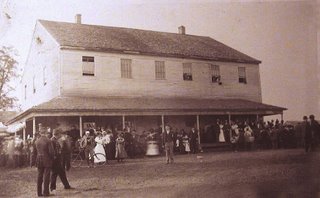
The 1816 Farmington Quaker Meetinghouse is the focus of a major community preservation effort designed to stabilize and preserve the building, restore it to its historic appearance, and donate it to an appropriate historical agency for use as an educational and tourism center to interpret the nationally important history of Farmington as a site important to woman’s rights, Quakers and Native Americans, and abolitionism and the Underground Railroad, reflecting national debates about American ideals of equality.
National Importance of This Building
The 1816 Farmington Quaker Meeting is nationally important for its association with major reform movements before the Civil War, including the woman’s rights movement, Native American rights, and the Underground Railroad. Famous Americans associated with this meetinghouse include Lucretia Mott, Austin Steward, Elizabeth Cady Stanton, and Susan B. Anthony.
As an 1816 building, this meetinghouse is perhaps the largest pre-canal building in central and western New York. It is also the second earliest known Quaker meetinghouse still standing west of the colonial settlement area in the U.S. Twenty-five Quaker meetings from all over western New York, Ontario, and Michigan originated from Farmington meeting.
The 1816 Farmington Quaker Meetinghouse was a center for debates about woman’s rights. In 1838, Genesee Yearly Meeting of Friends at Farmington stated that “men’s and women’s meetings for discipline stand on equal footing of common interest and common right.” In 1848, Quakers at Farmington formed the Yearly Meeting of Congregational Friends, in which men and women, blacks and whites met together on a basis of complete equality, joined not by creeds but by “practical righteousness.” At least one-quarter of the signers of the Declaration of Sentiments at the first woman’s rights convention at Seneca Falls in July 1848 came from Farmington Quarterly meeting. Elizabeth Cady Stanton spoke in this meetinghouse in October 1848, and Susan B. Anthony spoke here in 1873 at the time of her trial for voting.
The 1816 Farmington Quaker Meetinghouse represents the historic relationship of mutual respect between Quakers and Native Americans. In 1838, after the loss of all Seneca lands in the Treaty of Buffalo Creek, Seneca chiefs and clan mothers appealed here for Quaker assistance. With Quaker help, Seneca people negotiated a compromise treaty in 1842, retaining homelands at Allegany and Cattaraugus. “We pulled the strings and the world’s people danced,” said one Quaker.
The 1816 Farmington Quaker Meetinghouse was a nationally important Underground Railroad center. As early as 1815, freedom seeker Austin Steward stayed with the Otis Comstock family in Farmington and most likely helped build this meetinghouse. From the 1830s through the 1860s, Farmington families worked closely with an Underground Railroad network associated with Frederick Douglass and Amy Post in Rochester and William Chaplin in Washington, D.C. Freedom seekers William Wells Brown and Sarah and Emily Edmonson lived for a time in Farmington.
Economic Importance
Because of the national importance of this building, the 1816 Farmington Quaker Meetinghouse will provide a source of economic development to Farmington and central New York through heritage tourism. The meetinghouse will be a key link on:
- National Park Service’s proposed Votes for Women Trail
- National Park Service’s Underground Railroad Network to Freedom
- Heritage New York’s Underground Railroad Trail, and
- Heritage New York’s Women’s History Trail
